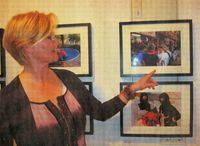Analogy and tiny details in paired comparisons
Photo exhibition "Look, twice!" of Maria Dorn at the Remisen-Gallery offers bitter-sweet irony and admonishing sociocriticism.
The insisting request "Look, twice!" of the exhibition's title, the audience took it to heart. Because only by a thorough study of the small-formatted photos one discovered important details. Always pair-wise two pictures belonged together and the detection of the corresponding, sometimes contrary comparison portions disclosed eye-tweaking humor, bitter-sweet irony or provokingly admonishing sociocriticism. Maria Dorn's exhibition at the Remisen-Gallery in Schloss Philippsruhe will continue until October 21.
 The connections between the pictures unfolded especially thru their titles, thereby interpreting each other. "Increasing", air plane traffic and "Decreasing", glacier tables in Canada; "Child's Play", Hanau boys and girls on a playground and "Child's Play?", a shepherd boy with his sheep in a desert in Syria; "Market Economy I", shop-till-you-drop tourists in NYC and "Market Economy II", veiled Syrian girls trying to sell woven fabrics in front of a sparse landscape, motivated to think about global order and the merciless capital markets or the advancing environmental pollution and the threatening global warming.
The connections between the pictures unfolded especially thru their titles, thereby interpreting each other. "Increasing", air plane traffic and "Decreasing", glacier tables in Canada; "Child's Play", Hanau boys and girls on a playground and "Child's Play?", a shepherd boy with his sheep in a desert in Syria; "Market Economy I", shop-till-you-drop tourists in NYC and "Market Economy II", veiled Syrian girls trying to sell woven fabrics in front of a sparse landscape, motivated to think about global order and the merciless capital markets or the advancing environmental pollution and the threatening global warming.
The single-sided view of issues was constantly put into extremely intelligent perspective. "You too can move the world", the Che Guevara air brush encourages on a Grossauheim truck, "…can you?" the partner asks, a run-down car wreck in an Indian Reservation near a canyon in Arizona. The dream of a better world anyone of the children of the western prosperity can dream next to the broken dreams of the almost exterminated Native Americans born already on the loser's side of the world reveal a multilayered breadth of vision onto the world, far off from stereotypical clichés or prefabricated positions
But also banal, amusing analogies found entrance into the exhibition. So the photo of the bottoms of an antique statue was hanging next to the gorgeous, hot-pants-covered buttocks of an Italian transvestite, the wrinkled, wise face of an age-old Ecuadorian woman next to a flashy rouged, disguised American Halloween-Beauty and close-ups of colored crayons next to cut-down tree trunks. A little girl thrown into the air by bungee ropes on a wine festival and an aged woman in a wheel chair had age as the common ground, while somewhere else quivering cold winter was placed next to hot summer or simply color or patterning of orange power sockets are compared to "The Gates" in Central Park.
The snap-shots were altogether non-arranged situational impressions and emerged independently during Maria Dorn's different journeys around the globe. The idea of pairing of two photographs across continents, borders and cultures, detached in time and location, crossed the photographer's mind only in retrospect. The commonality and the contrasts which associated people or situations in the paired pictures, the mutual interpretation of the coupled images, and the opportunity for critical discourse, forced by combination and title, catapulted this exhibition into the spheres of a comparative sociocritical study. Rightly so, one can say that Maria Dorn's photo exhibition opened by Joerg Eyfferrth from the Hanau Culture Society as well as by Andreas Saffranmueller and Harry Schneider-Reckels was the most intelligent, smart and double-edged event the Remisen-Gallery has seen in a long time.

